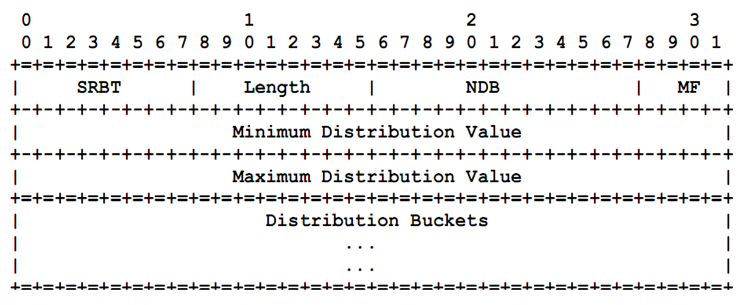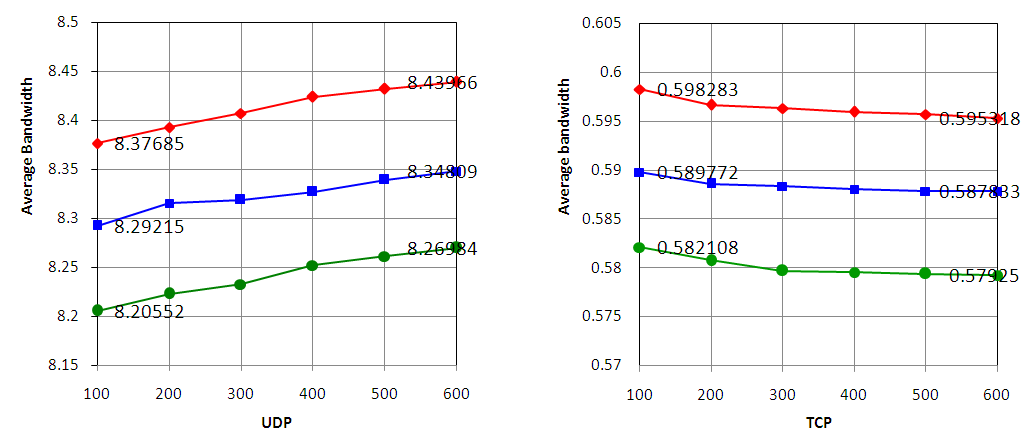-
Paper Information
- Paper Submission
-
Journal Information
- About This Journal
- Editorial Board
- Current Issue
- Archive
- Author Guidelines
- Contact Us
Journal of Wireless Networking and Communications
p-ISSN: 2167-7328 e-ISSN: 2167-7336
2017; 7(2): 31-34
doi:10.5923/j.jwnc.20170702.01

Examining RTP Traffic in Multimedia Conferencing System over TCP and UDP
Muatamed Abed Hajer
College of Computer Science & Information Technology- Sumer University, Iraq
Correspondence to: Muatamed Abed Hajer, College of Computer Science & Information Technology- Sumer University, Iraq.
| Email: |  |
Copyright © 2017 Scientific & Academic Publishing. All Rights Reserved.
This work is licensed under the Creative Commons Attribution International License (CC BY).
http://creativecommons.org/licenses/by/4.0/

The literature showed the potential impact of various applications of multimedia videoconferencing to different domains and contexts. Hence, ensuring efficient and effective utilization of multimedia videoconferencing networks is essential for industry experts and researchers. This paper examined the effect of real-time transport protocol (RTP) in improving the quality of service (QoS) for multimedia conferencing system. This solution was tested over IP and UDP. The evaluation was based on the use of NS2 in order to assess the volume of packet loss during the multimedia transmission. The result showed the compatibility and efficiency of the proposed solution.
Keywords: Multimedia networks, IP, UDP, RTP, QoS
Cite this paper: Muatamed Abed Hajer, Examining RTP Traffic in Multimedia Conferencing System over TCP and UDP, Journal of Wireless Networking and Communications, Vol. 7 No. 2, 2017, pp. 31-34. doi: 10.5923/j.jwnc.20170702.01.
Article Outline
1. Introduction
- The current advancement in technology and integration of multiple channels for facilitating network communication have led researchers to investigate reliable ways for sustaining and improving service quality (Saveliev & Ronzhin, 2015). Multimedia videoconferencing is an example that mostly depend on the bandwidth normalization for signal and data transmission (Debbabi, Kammoun, & Bouallegue, 2014). The application of most multimedia system for establishing real time communication relay mostly on the components of distributed architecture that help process multiple inputs into a compromised orders/requests. The literature showed that balancing between the outgoing and incoming requests can results in a better service quality and improve the overall performance of a system. However, little is known about the application of real-time transport protocol (RTP) in improving the service quality of videoconferencing in certain contexts. Therefore, this study was conducted in order to provide an in-depth understanding of how RTP can offer a better service over IP and UDP. It is assumed that using RTP may effectively contribute to the overall management of incoming and outgoing requests and as such the delivery of data (Mao, Bushmitch, Narayanan, & Panwar, 2006; MeLampy et al., 2006; Tan & Zakhor, 1999). The proposed architecture for this study is explained based on the main components of server, client, compression and decompression of data. This is believed to provide an insightful avenue for future studies to follow or adapt.
1.1. Server
- In this study, the server is corresponded to the main component of the proposed architecture for videoconferencing by providing the necessary elements for other clients. Here, the independent processing of incoming requests is developed to accommodate various network settings and conditions for the aim of extending service capacity. However, it is invisible to users because the system runs transparently, as demonstrated in a study by previous studies. In this component, it was proposed that the system administrator can access this server to accomplish certain ongoing tasks. As such, only one server component can be used to provide the proper coordination of various real-time sessions and control between clients who establish new connections. In addition, the communications between clients is also processed based on the bandwidth level that compress of signal related properties (Brosh, Baset, Rubenstein, & Schulzrinne, 2008; Schulzrinne, Casner, Frederick, & Jacobson, 2003).
1.2. Client
- The client component consists of certain personal computers (PCs) that are typically configured with suitable audio and video capture or playback hardware. In this study, the client side consists of a graphical user interface through which enable clients to interact with the system effectively by allowing them to create and execute required operations and by logging out through configured video and audio capture or playback hardware. On the other hand, there are certain aspects that are needed to be considered when configuring this component, these are; communication model, content model, control model, compression/ decompression module, and multimedia elements model.
1.3. Data Compression and Data Decompression
- Because multimedia data require high processing power, and compression of a continuous stream takes up more resources, this led us to consider the use of separate machine in order to provide a reliable compression of data when processing clients’ requests from other machines. With this in mind, the quality of service may be effected, therefore, we proposed providing a comprehensive data compression of video and audio data based on the RTP. In this study, we determined the main aspects for facilitating data composition within the client component for the aim of transmitting the multimedia elements via the Internet, this was believed to help us get the required services by reducing the cost of bandwidth needed for data to be transmitted from one client to another. It also helps facilitating the network degradation of the throughput in real-time settings.On the other hand, this service is also claimed to reduce any potential delay in processing incoming and outgoing requests as it play a key role in medicating the data processing that could incur excessive delays. In addition, the literature showed that such compression of data in multimedia system may help promote the internet connectivity by reducing the loss in internet connection by reducing the packet loss ratio when network experiences congestion as well as serious degradation of video quality.
2. Method
- Previous studies have repeatedly characterized the application of RTP in promoting the companion control of service. The standard settings of RTP are assumed to offer a reliable measure for multimedia systems by providing the necessary control for a service flow streaming in according to the connected devices configuration. This service comes with other predefined components in a network through which the processing data is being treated as a decomposed element of a network. Perkins (2003) stated that data packets are typically sent every few milliseconds, the control protocol operates on the scale of seconds. Based on these assumptions, we considered RTP as a reliable protocol for synchronization between media streams by facilitating the process of processing and managing requests received from different clients in real-time settings. This include the sender side to which RTP time is configured in according to the streaming and sender clock (Liang, Apostolopoulos, & Girod, 2008), which allows audio and video synchronization of information from the receivers.In addition, previous studies showed that the application of RTP packets may help in promoting the overall performance a system by simplifying the QoS monitoring. Meanwhile, may studies addressed the potential of RTP in saving the network bandwidth by maintaining the steaming. This include generating both sender and receiver reports in order to help in sharing bandwidth data for assessing and regulating service needs. The processed information can be used to facilitate the work of TCP that is similar to the control mechanism implied with the UDP. The network management tool may participate in monitoring the network performance based on the RTP packets or identify the faulty parts of the network. For example, RTP packets can be used to carry a transport-level identifier for identified RTP sources, which is employed to keep track of each participant. Source description packets may also contain other textual information that can be used to identify the path of source. Although the source of the RTP packets is already determined by the synchronization source (SSRC), an application could use multiple RTP streams, which can be easily associated with the processed and stored information.Tan and Zakhor (1999) addressed the potential of using point to point real-time video transmission scheme over the Internet which consists of using TCP in conjunction with a novel compression method. This was essential to reduce the error and ensure bandwidth-scalability. Authors considered compressing the video files into individually decodable packets of equal visual elements in which the processed packets can be truncated to instantaneously meet the time varying bandwidth. This implementation resulted in a better Internet traffic and better experience. Another study by Handley, Wakeman, and Crowcroft (1995) presented the potential of using conference control channel protocol in order to promote the current process associated with controlling conferences meetings with regards to the number of clients involved. They addressed the main requirements of such a scheme, and present a framework for building systems that connect new and existing applications. However, certain limitations may be found in terms of service reliability when communicating in different contexts.Based on these, the researcher in this study performed and generated simulation scenarios using NS-2 and the process of current multimedia conferencing system in facilitating real-time communications. The main aim was to ensure the audio and video quality and reduce communication errors that may accompany such utilization in multimedia systems.Figure 1 below shows the packet structure of the report block.
 | Figure 1. An illustration of packet structure (SRBT indicates sub-report block type; NDB, number of distribution buckets; MF, multiplicative factor) |
 | (1) |
3. Results
- In the proposed architecture, one server was multicast streaming the video in order to help increase the associated number of clients. In the multimedia packet transmission, the receiver was used to help determine the exact loss in packets based on calculating the difference of the sequences of the RTP sequence numbers when clients are communicated in a network. In this study, we considered examining the packet loss rate as a ratio of packets lost during the transmission over the packets received by the multimedia conferencing client during the sample time interval. Figure 2 illustrates a comparison of the packet losses in the multimedia conferencing and the proposed solution. It is evident from the result that the proposed architecture based RTP helped reduce the packet loss in multimedia conferencing system in according to the frame rates of the packets. However, the normal multimedia conferencing cannot. Hence, it has a great impact on the quality of the video, especially during the feedback process.
 | Figure 2. Overall packet loss when using the proposed architecture in three working scenarios |
4. Conclusions
- This study was carried out in order to determine the feasibility of RTP in facilitating the QoS for multimedia videoconferencing systems. Both UDP and TCP were used in order to assess the proposed architecture performance using NS2. A decision feedback scheme was designed and implemented for in real-time settings in which data from both sender and receiver were used for packet loss. The results obtained showed that the proposed RTP in multimedia videoconferencing systems provided a reliable performance when it was utilized over TCP and UDP protocols.
 Abstract
Abstract Reference
Reference Full-Text PDF
Full-Text PDF Full-text HTML
Full-text HTML